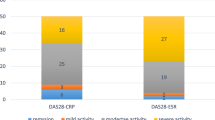Abstract
The aim of this study was to estimate the serum concentration of carbohydrate-deficient transferrin (CDT) in patients with rheumatoid arthritis (RA) and the relationship between the CDT level and disease activity in RA patients. Studies were carried out in 47 female patients with RA and 32 healthy women. Disease activity of RA was evaluated using the 28-joint count Disease Activity Score (DAS 28). Serum CDT was determined by particle-enhanced immunononephelometry using the N Latex CDT test. Patients with RA had significantly lower serum concentrations of CDT compared with controls. The correlation study showed the significant negative relationship between CDT and DAS 28 (r = − 0.483, p = 0.011). There were no correlations between serum CDT level and patient’s age, disease duration, number of tender and swollen joints, and degree of disability evaluated by the Health Assessment Questionnaire. The level of CDT in patients with RA was significantly decreased and confirms the changes in transferrin glycosylation which are dependent on the disease activity. Therefore, measurement of CDT in the sera of patients with RA can be useful for the evaluation of disease activity in these patients.
Zusammenfassung
Ziel der Studie war es, die Serumkonzentration von Carbohydrate-Deficient Transferrin (CDT) bei Patienten mit rheumatoider Arthritis (RA) und den Zusammenhang zwischen dem CDT-Spiegel und der Krankheitsaktivität bei RA-Patienten zu ermitteln. Studienteilnehmer waren 47 Patientinnen mit RA und 32 gesunde Frauen. Die Krankheitsaktivität wurde anhand des auf 28 Gelenke bezogenen Disease Activity Score (DAS 28) bestimmt. Das Serum-CDT wurde durch partikelverstärkte Immunnephelometrie mit dem N-Latex-CDT-Test gemessen. Die RA-Patientinnen wiesen signifikant niedrigere Serumkonzentrationen von CDT als die Kontrollen auf. Die Korrelationsstudie zeigte die signifikante negative Beziehung zwischen CDT und Krankheitsaktivitätswert (DAS 28; r = − 0,483; p = 0,011). Es gab keine Korrelation zwischen dem Serum-CDT-Spiegel und dem Patientenalter, der Krankheitsdauer, der Anzahl der empfindlichen und geschwollenen Gelenke sowie dem Grad der Behinderung gemäß Health Assessment Questionnaire. Der CDT-Spiegel bei RA-Patienten war signifikant vermindert und bestätigt Veränderungen bei der Transferrin-Glykosylierung, die von der Krankheitsaktivität abhängig sind. Daher können Messungen des CDT im Serum von RA-Patienten zur Beurteilung der Krankheitsaktivität sinnvoll sein.

Similar content being viewed by others
References
Alturfan AA, Uslu E, Alturfan EE et al (2007) Increased serum sialic acid levels in primary osteoarthritis and inactive rheumatoid arthritis. Tohoku J Exp Med 213:241–248
Arndt T (2001) Carbohydrate-deficient transferrin as a marker of chronic alcohol abuse: a critical review of preanalysis, analysis and interpretation. Clin Chem 47:13–27
Arnett FC, Edworthy SM, Bloch DA et al (1988) The American Rheumatism Association 1987 revised criteria for the classification of rheumatoid arthritis. Arthritis Rheum 31:315–324
Axford JS (1999) Glycosylation and rheumatic diseases. Biochim Biophys Acta 1455:219–229
Feelders RA, Vreugdenhil G, Jong G de et al (1992) Transferrin microheterogeneity in rheumatoid arthritis. Relation with disease activity and anemia of chronic disease. Rheumatol Int 12:195–199
Fries JF, Spitz P, Kraines RG et al (1980) Measurement of patient outcome in arthritis. Arthritis Rheum 23:137–145
Gindzienska-Sieskiewicz E, Klimiuk PA, Kisiel DG et al (2007) The changes in monnosaccharide composition of immunoglobulin G in the course of rheumatoid arthritis. Clin Rheumatol 26:685–690
Jeppsson JO, Kristensson H, Fimiani C (1993) Carbohydrate-deficient transferrin quantified by HPLC to determine heavy consumption of alcohol. Clin Chem 39:2115–2120
Keusch JJ, Lydyard PM, Delves PJ (1998) The effect on IgG glycosylation of altering beta1,4-galactosyltransferase-1 activity in B cells. Glycobiology 8:1215–1220
Raghav SK, Gupta B, Agrawal C et al (2006) Altered expression and glycosylation of plasma proteins in rheumatoid arthritis. Glycoconj J 23:167–173
Routier FH, Hounsell EF, Rudd PM et al (1998) Quantitation of the oligosaccharides of human serum IgG from patients with rheumatoid arthritis: a critical evaluation of different methods. J Immunol Methods 213:113–130
Sillanaukee P, Strid N, Allen JP et al (2001) Possible reason why heavy drinking increases carbohydrate-deficient transferrin. Alcohol Clin Exp Res 25:34–40
Sillanaukee P, Strid N, Jousilahti P et al (2001) Association of self-reported diseases and health care use with commonly used laboratory markers for alcohol consumption. Alcohol Alcohol 36:339–345
Heijde D van der, Hof MA van’t, Riel PL van et al (1990) Judging disease activity in clinical practice in rheumatoid arthritis: first step in the development of disease activity score. Ann Rheum Dis 49:916–920
Watson M, Rudd PM, Bland M et al (1999) Sugar printing rheumatic diseases. A potential method for disease differentiation using immunoglobulin G oligosaccharides. Arthritis Rheum 42:1682–1690
Xin Y, Lasker JM, Lieber CS (1995) Serum carbohydrate-deficient transferrin: mechanism of increase after chronic alcohol intake. Hepatology 22:1462–1468
Conflict of interest
The corresponding author states that there are no conflicts of interest.
Author information
Authors and Affiliations
Corresponding author
Rights and permissions
About this article
Cite this article
Cylwik, B., Chludzinska, A., Chrostek, L. et al. Relationship between CDT and disease activity in rheumatoid arthritis. Z. Rheumatol. 71, 220–223 (2012). https://doi.org/10.1007/s00393-011-0853-z
Published:
Issue Date:
DOI: https://doi.org/10.1007/s00393-011-0853-z
Keywords
- Carbohydrate-deficient transferrin
- Rheumatoid arthritis
- Disease activity score
- Severity of illness index



